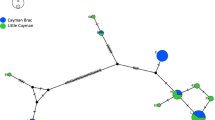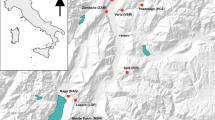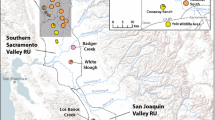Abstract
Anthropogenic habitat loss and fragmentation have been implicated in the endangerment and extinction of many species. Here we assess genetic variation and demographic history in the southernmost population of giant pandas (Ailuropoda melanoleuca) that continues to be threatened by habitat degradation and fragmentation, using noninvasive genetic sampling, mitochondrial control region sequence and 12 microsatellite loci. Compared to other giant panda populations, this population has medium-level genetic diversity based on the measure of both mitochondrial and nuclear markers. Mitochondrial DNA-based demographic analyses revealed that no historical population expansion or contraction has occurred, indicating a relatively stable population size. However, a Bayesian-coalescent method based on the observed allele distribution and allele frequencies of microsatellite clearly did detect, quantify and date a recent decrease in population size. Overall, the results indicate that a population contraction in the order of 95–96% has taken place over the last 910–999 years and is most likely due to anthropogenic habitat loss. These findings highlight the need for a greater focus on habitat protection and restoration for the long-term survival of this giant panda population.




Similar content being viewed by others
References
Bandelt HJ, Forster P, Röhl A (1999) Median-joining networks for inferring intraspecific phylogenies. Mol Biol Evol 16:37–48
Beaumont MA (1999) Detecting population expansion and decline using microsatellites. Genetics 153:2013–2029
Busch JD, Waser PM, DeWoody JA (2007) Recent demographic bottlenecks are not accompanied by a genetic signature in banner-tailed kangaroo rats (Dipodomys spectabilis). Mol Ecol 16:2450–2462
Cornuet JM, Luikart G (1996) Description and power analysis of two tests for detecting recent population bottlenecks from allele frequency data. Genetics 144:2001–2014
Durka W, Bossdorf O, Prati D, Auge H (2005) Molecular evidence for multiple introductions of garlic mustard (Alliaria petiolata Brassicaceae) to North America. Mol Ecol 14:1697–1706
Excoffier L, Laval G, Schneider S (2005) Arlequin ver 3.0: an integrated software package for population genetics data analysis. Evol Bioinform Online 1:47–50
Frankham R, Ballou JD, Briscoe DA (2002) Introduction to conservation genetics. Cambridge University Press, Cambridge, UK
Fu YX (1997) Statistical tests of neutrality of mutations against population growth hitchhiking and background selection. Genetics 147:915–925
Fu YX, Li WH (1993) Statistical tests of neutrality of mutations. Genetics 133:693–709
Garza JC, Williamson EG (2001) Detection of reduction in population size using data from microsatellite loci. Mol Ecol 10:305–318
Goossens B, Chikhi L, Ancrenaz M, Lackman-Ancrenaz I, Andau P, Bruford MW (2006) Genetic signature of anthropogenic population collapse in orang-utans. Plos Biol 4:285–291
Goudet J (2001) FSTAT: a program to estimate and test gene diversities and fixation indices, version 2.9.3. Lausanne University, Lausanne
Harpending H (1994) Signature of ancient population growth in a low-resolution mitochondrial DNA mismatch distribution. Hum Biol 66:591–600
Hu JC (2001) Research on the giant panda. Shanghai Publishing House of Science and Technology, Shanghai
Hu JC, Schaller GB, Pan WS, Zhu J (1985) The giant panda of Wolong. Sichuan Publishing House of Science and Technology, Chengdu
Hu YB, Zhan XJ, Qi DW, Wei FW (2010) Spatial genetic structure and dispersal of giant pandas on a mountain-range scale. Conserv Genet 11:2145–2155
Hughes JB, Daily GC, Ehrlich PR (1997) Population diversity: its extent and extinction. Science 278:689–692
Kuhner MK, Yamato J, Felsenstein J (1998) Maximum likelihood estimation of population growth rates based on the coalescent. Genetics 149:429–434
Lan Y (1993) Preliminary study of historic climate in southwest China. J Chinese Hist Geogr 2:13–39
Librado P, Rozas J (2009) DnaSP v5: a software for comprehensive analysis of DNA polymorphism data. Bioinformatics 25:1451–1452
Lin HR (1986) Historic changes of forests in Sichuan Province, China. Chinese Agric Archaeol 6:215–240
Lu Z, Johnson WE, Menotti-Raymond M, Yuhki N, Martenson JS, Mainka S, Huang SQ, Zhang ZH, Li GH, Pan WS, Mao XR, O’Brien SJ (2001) Patterns of genetic diversity in remaining giant panda populations. Conserv Biol 15:1596–1607
Luikart G, Allendorf FW, Cornuet JM, Sherwin WB (1998) Distortion of allele frequency distributions provides a test for recent population bottlenecks. J Hered 89:238–247
McKelvey KS, Schwartz MK (2005) DROPOUT: a program to identify problem loci and samples for noninvasive genetic samples in a capture-mark-recapture framework. Mol Ecol Notes 5:716–718
Nei M (1987) Molecular evolutionary genetics. Columbia University Press, New York
Newman D, Pilson D (1997) Increased probability of extinction due to decreased genetic effective population size: experimental populations of Clarkia pulchella. Evolution 51:354–362
Okello JBA, Wittemyer G, Rasmussen HB, Arctander P, Nyakaana S, Douglas-Hamilton I, Siegismund HR (2008) Effective population size dynamics reveal impacts of historic climatic events and recent anthropogenic pressure in African elephants. Mol Ecol 17:3788–3799
Olivieri GL, Sousa V, Chikhi L, Radespiel U (2008) From genetic diversity and structure to conservation: genetic signature of recent population declines in three mouse lemur species (Microcebus spp.). Biol Conserv 141:1257–1271
Piry S, Luikart G, Cornuet JM (1999) BOTTLENECK: a computer program for detecting recent reductions in the effective population size using allele frequency data. J Hered 90:502–503
Qi DW, Hu YB, Gu XD, Li M, Wei FW (2009) Ecological niche modeling of the sympatric giant and red pandas on a mountain-range scale. Biodivers Conserv 18:2127–2141
Qin ZS (1990) Bamboo food resources of giant pandas and the regeneration of the bamboo groves in Sichuan. In: Hu JC (ed) Research and progress in biology of the giant panda. Sichuan Publishing House of Science and Technology, Chengdu, pp 103–111
Qu YH, Lei FM, Zhang RY, Lu X (2010) Comparative phylogeography of five avian species: implications for Pleistocene evolutionary history in the Qinghai-Tibetan plateau. Mol Ecol 19:338–351
Ramos-Onsins SE, Rozas J (2002) Statistical properties of new neutrality tests against population growth. Mol Biol Evol 19:2092–2100
Rogers AR, Harpending H (1992) Population growth makes waves in the distribution of pairwise genetic differences. Mol Biol Evol 9:552–569
Shen FJ, Watts PW, Zhang ZH, Zhang AJ, Sanderson S, Kemp SJ, Yue BS (2005) Enrichment of giant panda microsatellite markers using Dynal magnet beads. Acta Genet Sinica 32:457–462
Shriver MD, Jin L, Chakraborty R, Boerwinkle E (1993) VNTR allele frequency distributions under the stepwise mutation model: a computer-simulation approach. Genetics 134:983–993
Sih A, Jonsson BG, Luikart G (2000) Habitat loss: ecological evolutionary and genetic consequences. Trends Ecol Evol 15:132–134
Sousa V, Penha F, Collares-Pereira MJ, Chikhi L, Coelho MM (2008) Genetic structure and signature of population decrease in the critically endangered freshwater cyprinid Chondrostoma lusitanicum. Conserv Genet 9:791–805
State Forestry Administration of China (SFA) (2006) The 3rd national survey report on giant panda in China. Science Press, Beijing
Storz JF, Beaumont MA (2002) Testing for genetic evidence of population expansion and contraction: An empirical analysis of microsatellite DNA variation using a hierarchical Bayesian model. Evolution 56:154–166
Taberlet P, Griffin S, Goossens B, Questiau S, Manceau V, Escaravage N, Waits LP, Bouvet J (1996) Reliable genotyping of samples with very low DNA quantities using PCR. Nucleic Acids Res 24:3189–3194
Tamura K, Dudley J, Nei M, Kumar S (2007) MEGA4: molecular evolutionary genetics analysis (MEGA) software version 4.0. Mol Biol Evol 24:1596–1599
Tilman D, May RM, Lehman CL, Nowak MA (1994) Habitat destruction and the extinction debt. Nature 371:65–66
Valière N (2002) GIMLET: a computer program for analysing genetic individual identification data. Mol Ecol Notes 2:377–379
Van Oosterhout C, Hutchinson WF, Wills DPM, Shipley P (2004) MICRO-CHECKER: software for identifying and correcting genotyping errors in microsatellite data. Mol Ecol Notes 4:535–538
Walsh PS, Metzger DA, Higuchi R (1991) Chelex-100 as a medium for simple extraction of DNA for PCR-based typing from forensic material. Biotechniques 10:506–513
Wu H, Zhan XJ, Zhang ZJ, Zhu LF, Yan L, Li M, Wei FW (2009) Thirty-three microsatellite loci for noninvasive genetic studies of the giant panda (Ailuropoda melanoleuca). Conserv Genet 10:649–652
Zhan XJ, Li M, Zhang ZJ, Goossens B, Chen YP, Wang HJ, Bruford MW, Wei FW (2006) Molecular censusing doubles giant panda population estimate in a key nature reserve. Curr Biol 16:R451–R452
Zhan XJ, Zheng XD, Bruford MW, Wei FW, Tao Y (2010) A new method for quantifying genotyping errors for noninvasive genetic studies. Conserv Genet 11:1567–1571
Zhang YP, Wang XX, Ryder OA, Li HP, Zhang HM, Yong YG, Wang PY (2002) Genetic diversity and conservation of endangered animal species. Pure Appl Chem 74:575–584
Zhang BW, Li M, Ma LC, Wei FW (2006) A widely applicable protocol for DNA isolation from fecal samples. Biochem Genet 44:503–512
Zhang BW, Li M, Zhang ZJ, Goossens B, Zhu LF, Zhang SN, Hu JC, Bruford MW, Wei FW (2007) Genetic viability and population history of the giant panda, putting an end to the “evolutionary dead end”? Mol Biol Evol 24:1801–1810
Zhao L, Zhang J, Liu ZJ, Funk SM, Wei FW, Xu MQ, Li M (2008) Complex population genetic and demographic history of the Salangid, Neosalanx taihuensis based on cytochrome b sequences. BMC Evol Biol 8:201
Zhu SZ (2007a) Historic forest changes of the Liangshan Mountains in Sichuan Province. J Chinese Hist Geogr 22:43–52
Zhu SZ (2007b) Climate changes in the Liangshan Mountains since 10000 years before. Yunnan Geogr Environ Res 19:1–4
Zhu LF, Zhan XJ, Wu H, Zhang SN, Meng T, Bruford MW, Wei FW (2010) Conservation implications of drastic reductions in the smallest and most isolated populations of giant pandas. Conserv Biol 24:1299–1306
Acknowledgments
We thank the staff of Sichuan Forestry Department and the following nature reserves: Meigu-Dafengding, Mabian-Dafengding, Mamize, Shenguozhuang, Maanshan, Heizugou, and Jinkouhe Forestry Bureau for assistance during fieldwork. Especially, many thanks are given to Xiaodong Gu, Zongming Cao, Kui Fang, Guji Yang, Tianjian Gong, Zhuo Wang, Zhihong Li, Yongbin Liao, Weiming Yang and Bin Wang. We also thank two anonymous reviewers and the editor for comments and suggestions. This research was funded by the National Basic Research Program of China (973 Program, 2007CB411600) and the National Natural Science Foundation of China (grant 30830020).
Author information
Authors and Affiliations
Corresponding author
Rights and permissions
About this article
Cite this article
Hu, Y., Qi, D., Wang, H. et al. Genetic evidence of recent population contraction in the southernmost population of giant pandas. Genetica 138, 1297–1306 (2010). https://doi.org/10.1007/s10709-010-9532-2
Received:
Accepted:
Published:
Issue Date:
DOI: https://doi.org/10.1007/s10709-010-9532-2




